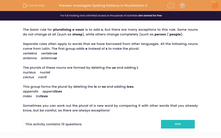The basic rule for pluralising a noun is to add s, but there are many exceptions to this rule.
Some nouns do not change at all (such as sheep), while others change completely (such as person becomes people).
Separate rules often apply to words that we have borrowed from other languages. All the following nouns come from Latin.
The first group add e instead of s to make the plural.
vertebra vertebrae
antenna antennae

The plurals of these nouns are formed by deleting the us and adding i.
nucleus nuclei
cactus cacti

This group form the plural by deleting the ix or ex and adding ices.
appendix appendices
index indices
Sometimes, you can work out the plural of a new word by comparing it with other words that you already know, but be careful, as there are always exceptions!







